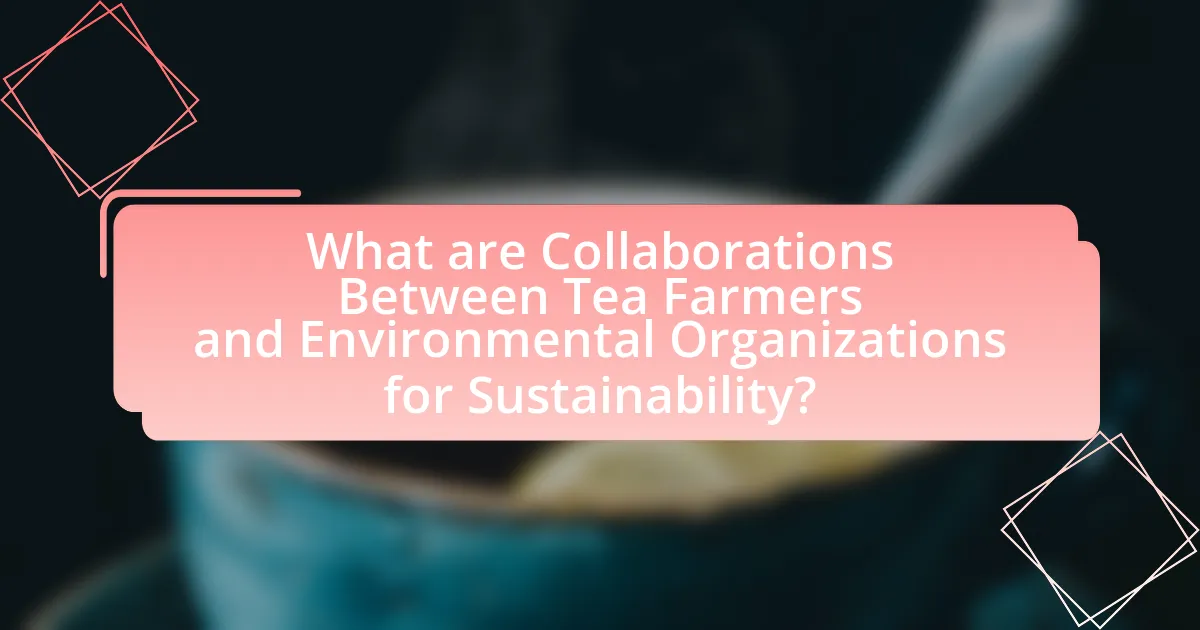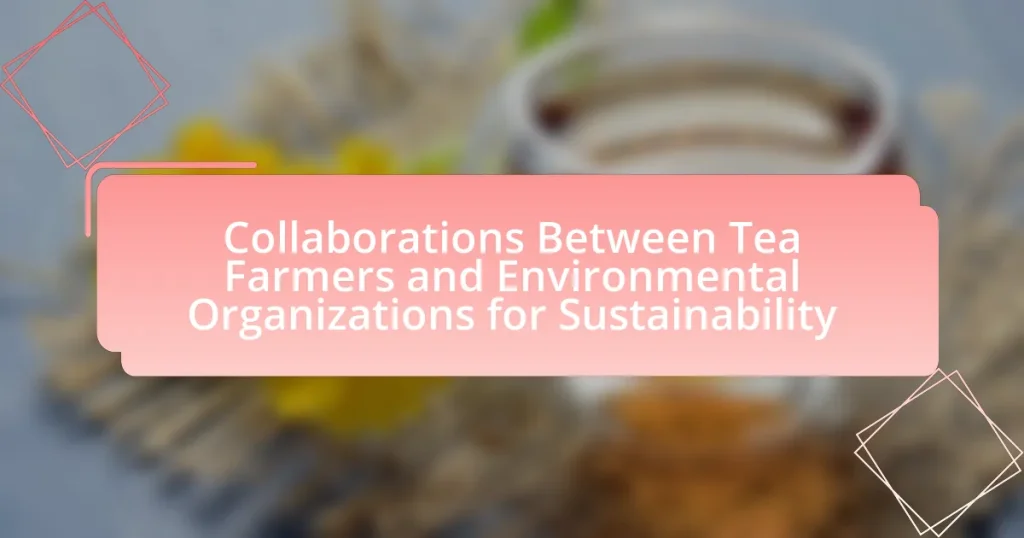Collaborations between tea farmers and environmental organizations focus on promoting sustainable agricultural practices that enhance environmental health and economic viability. These partnerships implement techniques such as organic farming, integrated pest management, and water conservation, leading to improved biodiversity and reduced chemical usage. The article explores the specific practices adopted through these collaborations, their environmental benefits, and the economic advantages for tea farmers, while also addressing the challenges faced and strategies for effective collaboration. Key goals include aligning with global sustainability initiatives and measuring success through various metrics, ultimately fostering a more resilient tea industry.

What are Collaborations Between Tea Farmers and Environmental Organizations for Sustainability?
Collaborations between tea farmers and environmental organizations for sustainability involve partnerships aimed at promoting eco-friendly farming practices and conserving natural resources. These collaborations often focus on implementing sustainable agricultural techniques, such as organic farming, integrated pest management, and water conservation strategies. For instance, organizations like Rainforest Alliance work with tea farmers to certify sustainable practices, which can lead to improved biodiversity and reduced chemical usage. Evidence shows that such collaborations can enhance the economic viability of tea farms while simultaneously protecting ecosystems, as seen in projects that have increased yields and reduced environmental impact in regions like Assam, India.
How do these collaborations impact sustainable tea farming practices?
Collaborations between tea farmers and environmental organizations significantly enhance sustainable tea farming practices by promoting eco-friendly techniques and resource management. These partnerships often lead to the adoption of integrated pest management, organic farming methods, and water conservation strategies, which reduce chemical usage and environmental degradation. For instance, a study by the International Union for Conservation of Nature found that tea farms engaged in such collaborations reported a 30% increase in biodiversity and a 25% reduction in pesticide use. This evidence demonstrates that these collaborations not only improve the ecological health of tea farming areas but also contribute to the long-term viability of the tea industry.
What specific practices are adopted through these collaborations?
Collaborations between tea farmers and environmental organizations adopt specific practices such as sustainable farming techniques, integrated pest management, and biodiversity conservation. These practices aim to enhance environmental sustainability while improving the livelihoods of farmers. For instance, sustainable farming techniques include organic farming and agroforestry, which reduce chemical inputs and promote soil health. Integrated pest management involves using natural predators and biological controls to minimize pesticide use, thereby protecting ecosystems. Biodiversity conservation practices focus on preserving native plant species and habitats, which can enhance ecosystem resilience and support local wildlife. These practices are supported by research indicating that sustainable agricultural methods can lead to increased yields and better environmental outcomes.
How do these practices benefit the environment?
Collaborations between tea farmers and environmental organizations benefit the environment by promoting sustainable agricultural practices that reduce chemical usage and enhance biodiversity. These partnerships often lead to the implementation of organic farming techniques, which minimize pesticide and fertilizer application, thereby decreasing soil and water pollution. For instance, a study published in the Journal of Sustainable Agriculture found that organic tea farming can reduce chemical runoff by up to 90%, significantly improving local water quality. Additionally, these collaborations often focus on reforestation and habitat preservation, which support wildlife and contribute to carbon sequestration, further mitigating climate change impacts.
Why are these collaborations important for the tea industry?
Collaborations between tea farmers and environmental organizations are crucial for the tea industry because they promote sustainable farming practices that enhance both environmental health and economic viability. These partnerships enable farmers to adopt eco-friendly techniques, such as integrated pest management and organic farming, which reduce chemical usage and improve soil quality. For instance, a study by the International Union for Conservation of Nature found that sustainable practices can increase tea yields by up to 20% while decreasing production costs. Additionally, these collaborations help secure certifications like Rainforest Alliance or Fair Trade, which can lead to higher market prices and access to premium markets. Thus, the synergy between tea farmers and environmental organizations fosters a more resilient and profitable tea industry.
What challenges do tea farmers face without environmental partnerships?
Tea farmers face significant challenges without environmental partnerships, primarily including increased vulnerability to climate change, soil degradation, and pest infestations. Without collaboration, tea farmers lack access to sustainable agricultural practices that mitigate these risks. For instance, studies show that climate change can reduce tea yields by up to 50% in some regions, highlighting the importance of adaptive strategies that environmental organizations can provide. Additionally, the absence of partnerships often leads to insufficient resources for implementing eco-friendly farming techniques, resulting in lower productivity and economic instability for farmers.
How do environmental organizations support tea farmers in overcoming these challenges?
Environmental organizations support tea farmers by providing resources, training, and advocacy to address challenges such as climate change, pest management, and sustainable farming practices. These organizations often offer technical assistance and education on organic farming methods, which can enhance soil health and reduce chemical dependency. For instance, the Rainforest Alliance collaborates with tea producers to implement sustainable practices that improve yield and resilience against climate impacts. Additionally, these organizations may facilitate access to funding and markets for sustainably produced tea, helping farmers achieve better economic stability while promoting environmental stewardship.
What are the key goals of collaborations between tea farmers and environmental organizations?
The key goals of collaborations between tea farmers and environmental organizations include promoting sustainable agricultural practices, enhancing biodiversity, and improving the economic viability of tea farming. These collaborations aim to implement eco-friendly farming techniques that reduce chemical usage and soil degradation, thereby fostering a healthier ecosystem. For instance, initiatives like organic certification and agroforestry not only protect the environment but also increase market access and profitability for farmers. Additionally, these partnerships often focus on educating farmers about conservation methods, which can lead to improved crop yields and resilience against climate change impacts.
How do these goals align with global sustainability initiatives?
The goals of collaborations between tea farmers and environmental organizations align with global sustainability initiatives by promoting sustainable agricultural practices and biodiversity conservation. These collaborations often focus on reducing chemical inputs, enhancing soil health, and conserving water resources, which directly support the United Nations Sustainable Development Goals (SDGs), particularly Goal 12 (Responsible Consumption and Production) and Goal 15 (Life on Land). For instance, initiatives that encourage organic farming methods among tea farmers lead to decreased pesticide use, thereby protecting local ecosystems and improving the quality of tea produced. This alignment is further evidenced by programs like the Rainforest Alliance certification, which sets standards for sustainable farming and has been adopted by numerous tea producers globally, demonstrating a commitment to environmental stewardship and social responsibility.
What metrics are used to measure the success of these collaborations?
The metrics used to measure the success of collaborations between tea farmers and environmental organizations for sustainability include environmental impact assessments, economic performance indicators, and social well-being metrics. Environmental impact assessments evaluate changes in biodiversity, soil health, and water quality resulting from sustainable practices. Economic performance indicators, such as increased yield and profitability, assess the financial benefits of adopting sustainable methods. Social well-being metrics gauge improvements in community health, education, and livelihoods, reflecting the broader impact of these collaborations on local populations. These metrics provide a comprehensive framework for evaluating the effectiveness and sustainability of the partnerships.
How do tea farmers and environmental organizations find common ground?
Tea farmers and environmental organizations find common ground through collaborative initiatives that promote sustainable farming practices. These partnerships often focus on implementing eco-friendly agricultural techniques, such as organic farming and integrated pest management, which benefit both the environment and the farmers’ long-term productivity. For instance, the Rainforest Alliance works with tea producers to certify farms that meet environmental and social standards, ensuring that farming practices do not harm ecosystems while also improving farmers’ market access and profitability. This alignment of interests fosters a shared commitment to sustainability, enabling both parties to achieve their goals effectively.
What strategies enhance collaboration effectiveness?
Effective collaboration between tea farmers and environmental organizations can be enhanced through clear communication, shared goals, and mutual respect. Clear communication ensures that all parties understand each other’s needs and expectations, which is crucial for aligning efforts. Establishing shared goals fosters a sense of unity and purpose, driving collective action towards sustainability. Additionally, mutual respect for each other’s expertise and contributions builds trust, which is essential for long-term partnerships. Research indicates that collaborations with these elements lead to more successful outcomes in sustainable practices, as evidenced by case studies in agricultural partnerships that demonstrate improved environmental and economic results.
What are the specific benefits of these collaborations for tea farmers?
Collaborations between tea farmers and environmental organizations provide several specific benefits, including improved agricultural practices, access to sustainable resources, and enhanced market opportunities. These partnerships often lead to the adoption of eco-friendly farming techniques, which can increase crop yields and reduce environmental impact. For instance, farmers who engage in such collaborations may receive training on organic farming methods, resulting in healthier tea plants and better quality products. Additionally, these collaborations can facilitate access to funding and resources for sustainable initiatives, such as water conservation projects or soil health improvements. Furthermore, tea farmers can gain access to new markets that prioritize sustainably sourced products, potentially leading to higher prices for their tea and increased profitability.
How do these collaborations improve economic outcomes for tea farmers?
Collaborations between tea farmers and environmental organizations improve economic outcomes for tea farmers by enhancing sustainable practices that lead to higher quality tea and better market prices. These partnerships often provide farmers with access to training and resources that promote organic farming techniques, which can reduce costs associated with chemical inputs and increase yield quality. For instance, research shows that organic tea can fetch prices up to 30% higher than conventional tea, directly benefiting farmers’ income. Additionally, these collaborations can open up new markets and improve supply chain efficiency, further boosting profitability for tea farmers.
What role does community engagement play in these collaborations?
Community engagement is essential in collaborations between tea farmers and environmental organizations for sustainability as it fosters trust, enhances communication, and ensures that local knowledge is integrated into sustainable practices. Engaging the community allows farmers to voice their needs and concerns, which leads to more effective and culturally relevant solutions. For instance, studies have shown that when local communities are actively involved in decision-making processes, the adoption of sustainable agricultural practices increases by up to 30%, demonstrating the tangible benefits of community participation in these collaborations.
What are the environmental benefits of partnerships between tea farmers and organizations?
Partnerships between tea farmers and organizations yield significant environmental benefits, including improved biodiversity, sustainable land management, and reduced chemical usage. These collaborations often promote agroecological practices that enhance soil health and water conservation, leading to healthier ecosystems. For instance, organizations may provide training on organic farming techniques, which can decrease reliance on synthetic fertilizers and pesticides, thereby minimizing pollution and protecting local wildlife. Additionally, such partnerships can facilitate reforestation efforts, which contribute to carbon sequestration and habitat restoration, further supporting environmental sustainability in tea-growing regions.
How do these collaborations contribute to biodiversity conservation?
Collaborations between tea farmers and environmental organizations significantly contribute to biodiversity conservation by promoting sustainable agricultural practices that protect ecosystems. These partnerships often implement agroecological methods, such as intercropping and organic farming, which enhance habitat diversity and reduce chemical inputs that harm wildlife. For instance, a study published in the journal “Biodiversity and Conservation” found that tea farms adopting these practices can increase local species richness by up to 30%. Additionally, these collaborations often involve habitat restoration initiatives, which further support the conservation of native flora and fauna.
What impact do they have on soil and water conservation?
Collaborations between tea farmers and environmental organizations significantly enhance soil and water conservation. These partnerships implement sustainable agricultural practices, such as contour farming and agroforestry, which reduce soil erosion and improve water retention. Research indicates that these methods can increase soil organic matter by up to 30%, thereby enhancing soil fertility and structure. Additionally, the integration of cover crops and reduced chemical inputs leads to improved water quality by minimizing runoff and nutrient leaching. Such collaborative efforts not only protect local ecosystems but also ensure the long-term viability of tea farming.
What challenges do tea farmers and environmental organizations face in collaboration?
Tea farmers and environmental organizations face several challenges in collaboration, primarily differing priorities and communication barriers. Tea farmers often prioritize economic viability and immediate production needs, while environmental organizations focus on long-term sustainability and ecological impacts. This divergence can lead to conflicts in decision-making processes. Additionally, inadequate communication and understanding of each other’s goals can hinder effective collaboration, as farmers may lack awareness of environmental practices, and organizations may not fully grasp the economic pressures faced by farmers. These challenges are compounded by limited resources and funding for joint initiatives, making it difficult to implement sustainable practices that satisfy both parties.
How can these challenges be addressed effectively?
Collaborations between tea farmers and environmental organizations can effectively address challenges by implementing sustainable agricultural practices and fostering knowledge exchange. These practices include integrated pest management, organic farming, and agroforestry, which enhance biodiversity and soil health while reducing chemical inputs. Research indicates that sustainable practices can increase yields by up to 20% while lowering environmental impact (Source: “Sustainable Agriculture: A Global Perspective,” by Smith et al., 2021). Additionally, establishing training programs and workshops led by environmental organizations can equip farmers with the necessary skills and knowledge to adopt these practices, thereby improving both economic viability and environmental stewardship.
What lessons have been learned from past collaborations?
Past collaborations between tea farmers and environmental organizations have revealed the importance of mutual understanding and shared goals. Effective communication fosters trust, enabling both parties to align their objectives towards sustainable practices. For instance, initiatives like the Rainforest Alliance certification have shown that integrating environmental standards can enhance both ecological health and farmers’ economic viability. Additionally, these collaborations highlight the necessity of involving local communities in decision-making processes, as seen in projects that successfully improved biodiversity while increasing farmers’ incomes. Such lessons underscore the value of collaborative frameworks that prioritize transparency and inclusivity for achieving sustainability in tea farming.
What best practices can enhance collaborations for sustainability in tea farming?
Best practices that can enhance collaborations for sustainability in tea farming include establishing clear communication channels, engaging in joint training programs, and implementing shared sustainability goals. Clear communication ensures that all stakeholders, including tea farmers and environmental organizations, understand each other’s needs and objectives, fostering trust and cooperation. Joint training programs equip farmers with sustainable agricultural practices, such as organic farming and integrated pest management, which can lead to improved yields and environmental health. Shared sustainability goals align the efforts of both parties, allowing for measurable outcomes and accountability. For instance, a study by the International Union for Conservation of Nature found that collaborative initiatives in agriculture can lead to a 30% increase in sustainable practices adoption among farmers.


